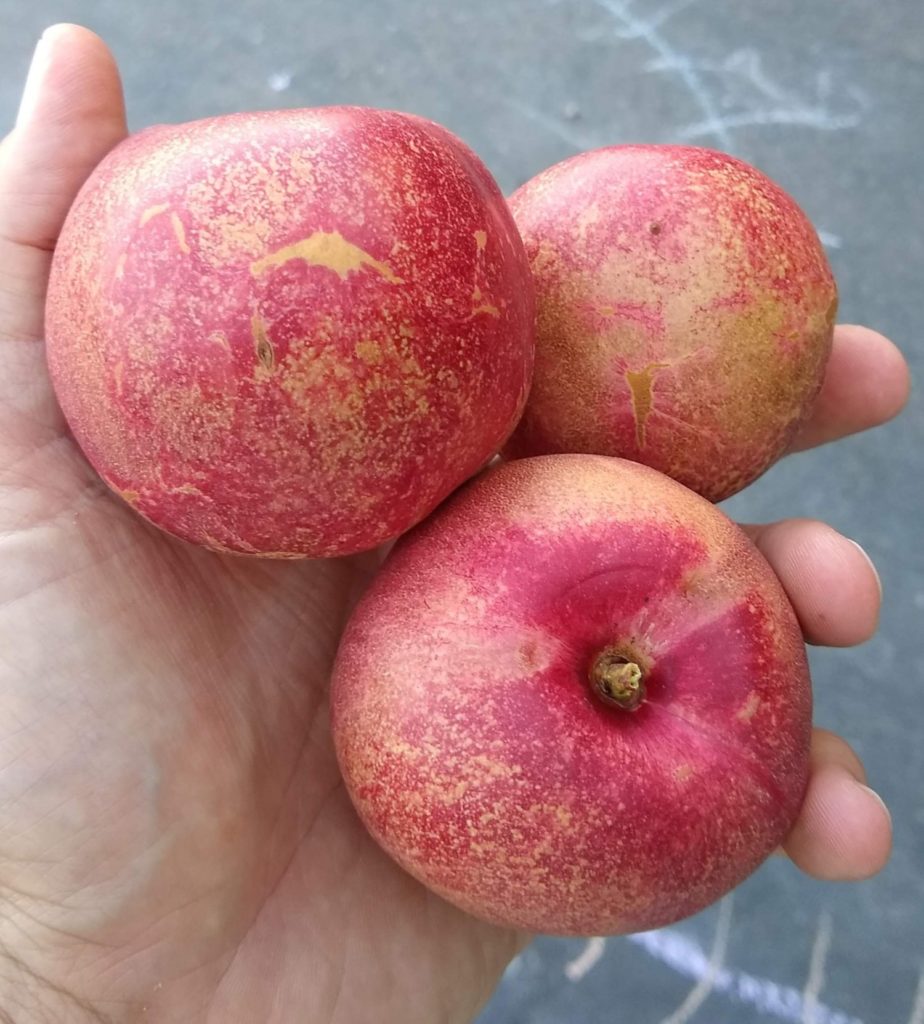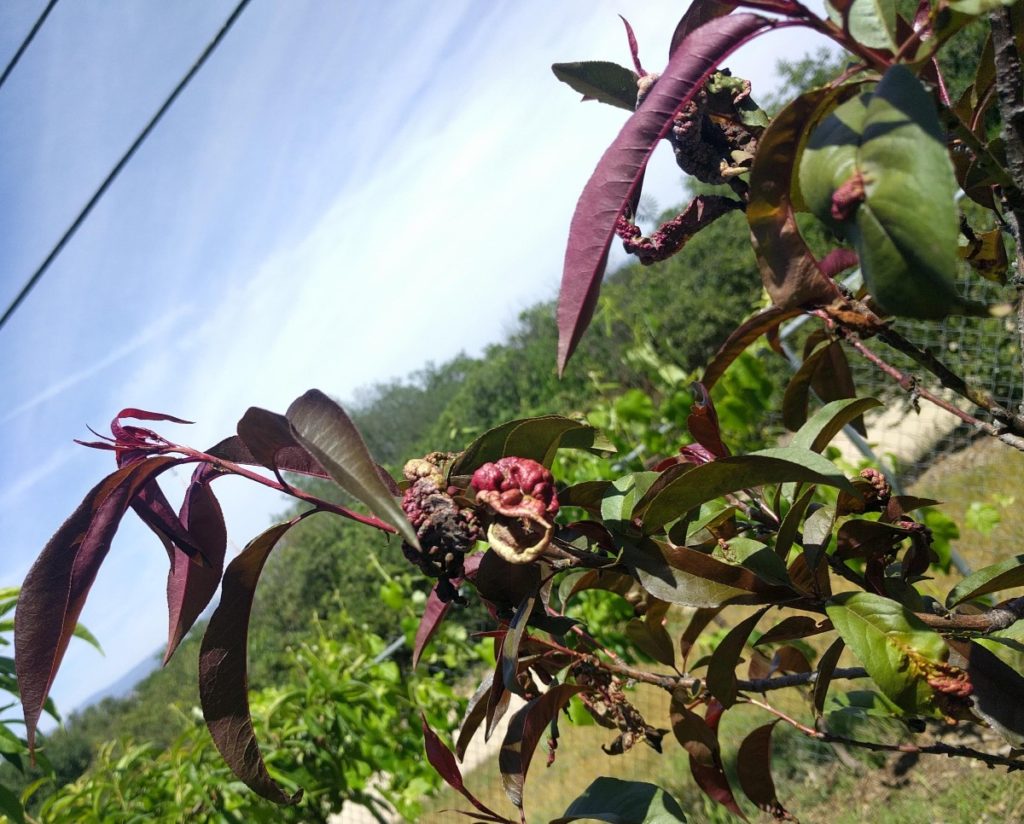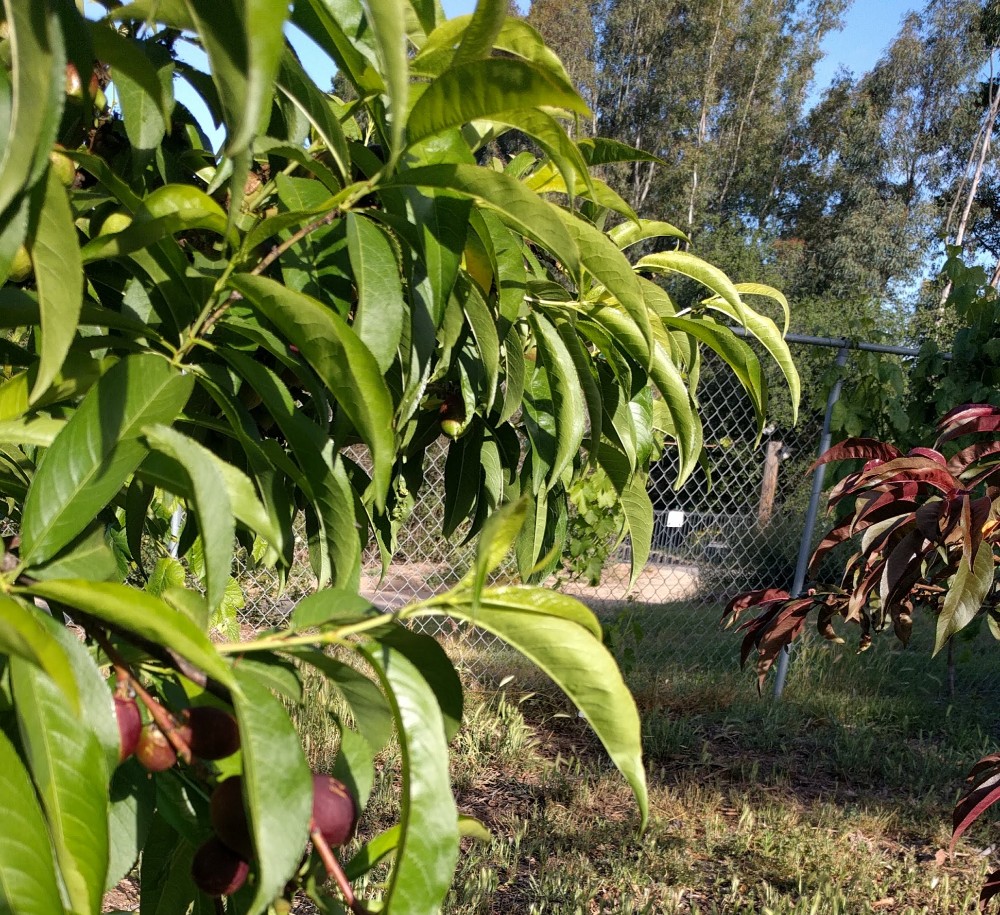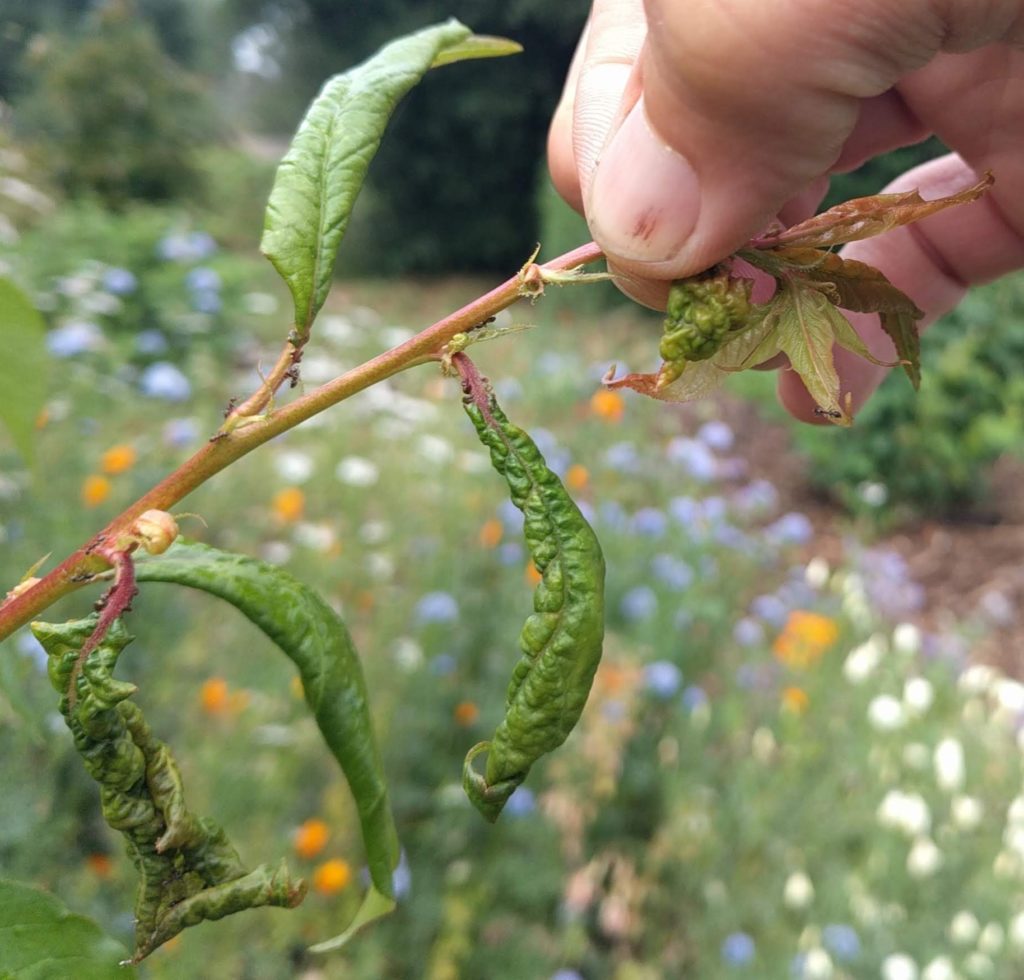“Here’s a minimum spray program for mixed fruit tree plantings: In December or January, or after pruning, apply a dormant spray such as oil and lime sulfur to apples, pears, peaches, plums — all fruits except those noted below — for control of scale insects and other overwintering insects or insect eggs. Use a copper spray with oil on apricots. Do not use oil sprays on walnuts. Use a spray of copper (Bordeaux solution) or lime sulfur on peaches for control of peach leaf [curl] in late winter before buds break.”
This advice comes from the original Sunset Western Garden Book of 1954.
Do you follow? You can’t.
Fast forward 66 years to today in 2020, and some of the products used then as dormant sprays are now outlawed or no longer manufactured or no longer allowed to be sold to and used by home gardeners. (Farmers are allowed to use many sprays that home gardeners are not.)
“In the past, peach leaf curl could be successfully controlled with lime sulfur fungicide or Microcop, a fixed copper fungicide. These products were removed from the retail market beginning in 2010. The only fungicide products left for treating peach leaf curl are those containing lower levels of copper (such as Liqui-Cop), copper soap, and the non-copper synthetic fungicide chlorothalonil (labeled by US EPA as “likely to be carcinogenic to humans”),” said Chuck Ingels of the University of California Cooperative Extension in his report on a 2012 Peach Leaf Curl Trial.
Furthermore, the products that are available today as dormant sprays for peach leaf curl appear to be less effective than the old products, as reported by Ingels in the above trial.
But what do I know? I only know anything about dormant spraying secondhand. I’ve never actually done any spraying of any of my deciduous fruit trees. So I have nothing further to say about whether, when, with what, or how you might spray your deciduous fruit trees this winter.
End of post? No, let me share why I have never done such spraying in the last fifteen years that I have been attentively growing deciduous fruit trees, as well as what the results have been. Maybe that is worth something in that it might help inform your decisions about dormant spraying.
Spray for peach leaf curl?
Peach leaf curl seems to be the disease that can be sprayed for during winter and that irritates the most people so I’ll continue focusing on it. I’ve had peach leaf curl on many peach and nectarine and nectaplum trees over the years and yet I’ve never bothered spraying for it because, well, look at the fruit:

Last spring, my SpiceZee nectaplum had bad leaf curl, but still very few fruit were affected. Peach leaf curl may be ugly:

But I don’t eat the leaves, so as long as I get satisfactory quality and quantity fruit then I see no need to intercede.
Also, from experience I know that peach leaf curl infections vary from year to year, depending on the weather. Last year, they were worse than usual because of our abnormally wet spring.
Infection also varies from variety to variety. Look at the nearly perfect foliage of the nectarine tree growing adjacent to the infected nectaplum tree:

And finally, how quickly a tree rebounds from the leaf curl infection appears to depend on how healthy and vigorous the tree is in general.
Here’s a video from spring 2020 showing some infected trees in my yard that have been left to fend for themselves, with no effort to prevent or fight peach leaf curl:
Spray for aphids?
I’ve also never bothered to spray for insects that might spend the winter on the bare branches of my deciduous fruit trees, such as aphids.

My young Flavor Grenade pluot tree had an infestation of aphids on its new growth at one point last summer. The leaves curled, and ants formed a highway running up the trunk to feed on the aphids’ honeydew.
I’d seen this happen on other plum and pluot trees in the past. I’d also seen it be really bad one year only for the next year to not have an aphid in sight. So I wasn’t worried. A tree’s growth is somewhat stunted by such an infestation but that means less pruning necessary. I see it as unattractive but not worth spraying for, especially as long as the fruit is not significantly affected, and it never has been.
(As mentioned by Conrad in the comments below, an excellent way to control aphids without spraying is to prevent the ants from climbing up into a tree, as the ants protect the aphids from predators. You can keep ants out of a tree by using something sticky around the trunk, such as the product Tanglefoot. You can also wrap the trunk in duct tape, sticky side out.)
Might the day come when I use a spray on a deciduous fruit tree during the dormant season? Maybe. And should that day come, I’ll share why and whether I found it worthwhile.
. . . it’s 2023 as I look at this post again, and I’ve still not found it worthwhile to spray.




I just planted a peach and plum tree last year and the peach has the hideous peach curl with red bumpy leaves. I didn’t even know about this problem till now so I didn’t prevent it and I sprayed it with copper fungicide the other day. I has buds but they got wet too.Is it going to destroy the fruit since I sprayed it too late in the game? Also the plum trees buds seem to be drying up after blooming and the tree is growing an excessive amount of leaves. Anything I can fertilize with to help fruit set?
Hi Bita,
Don’t worry about peach leaf curl destroying the fruit. Even the worst infections I’ve ever seen have little effect on the peach fruit.
For your plum, it might be that the blooms were not pollinated or they were pollinated and are now becoming fruit. If pollinated, the flowers still brown and dry up and look dead until a couple weeks later you notice little green pea-size plum fruit at the end of the stems. It’s hard to notice at first how much fruitset you have. I am always unsure on plums and pluots until the fruitlets get gumball size and I can start seeing them easily. But if you do have lots of new leaves, it might be that you don’t have much fruitset this year. No fertilizer will help this situation.
About aphids and ants. I got rid of aphids on my fruit trees without spraying. I read that the ants were actively protecting the aphids from aphid-predators like lacewing larva. I used a sticky product called “Tanglefoot” around the trunk of the tree near the base, to act as an impassable barrier to the ants. It is like Vasaline, but thicker than peanut butter, and very sticky. Without the ants to protect them, the natural aphid predators soon got the aphids under control.
I wasn’t sure if it was okay to apply the Tanglefoot directly to the tree bark, so I first wrapped a 2″-3″ section of the trunk with thin plastic, flagging tape, and applied the Tanglefoot to that. I also trimmed the branches to make sure nothing but the trunk was touching the ground. It worked great, and it was easy, and required nothing toxic.
Glad you mentioned this, Conrad. I have also gotten excellent control over aphids on various fruit trees through controlling the access of Argentine ants into the trees when possible. I’ve used Tanglefoot in the way you have, and I’ve also used duct tape (sticky side out). The key is, as you mention, making sure that the ants can’t access the canopy from any other avenue except the trunk. Thanks again for bringing this up.
The trouble I have had with Tanglefoot is the ants eventually defeat the barrier by forming a bridge of dead ants that living ants walk over. I’m guessing the only solution is to apply a fresh layer over the bridge of dead ants?
Yes, Axel. I have had the same experience and was tempted the other day to update the information above. Thanks for making me take the time to do so now.
When I’ve had good results from either Tanglefoot or duct tape, I’ve had to constantly monitor and reapply because of exactly what you describe. This is possible on a tree or two but impractical if you have many trees. I no longer use this method. I have been using KM Antpro for the last couple years, and very carefully and diligently for the last nine months or so. This is currently my preferred method of dealing with Argentine ants, in addition to occasionally blasting foliage with water.
Hi Greg,
I’ve seen KM Antpro mentioned in your blogs a couple of times. As this comment is a couple of years old, is that still your preferred method of dealing with ants? If so, would you mind detailing just how you decided where to place the stations and how often you fill them? How much coverage do you feel each station really provides?
I have a small garden with a hodge-podge of metal raised beds, wooden planter boxes, half barrels, grow bags, in-ground plantings, etc. It looks like KM Antpro recommends only 1 station to cover an open area my size (WAY under the 2,500 sq ft they specify), but will the ants in all my various random nooks and crannies really all find their way to one station? Would I just place it smack in the middle of the garden? Any insight would be much appreciated!
Hi Adrien,
I am still using my KM Antpro stations. It’s still the best option for my situation despite its drawbacks of being expensive and requiring maintenance. It definitely does not eliminate the ants, but it does reduce their numbers and negative effects.
I don’t think you would get much benefit from a single station in your garden unless you have few ants to start with. I have eight stations. I place one on each corner of my house, and then spread the other four throughout the irrigated part of my yard, which is roughly a third of an acre. I get acceptable results with this set up. There are still ants around though.
The most important part of placement is shade. If the station is in the sun, the bait inside heats up and the ants won’t feed on it except for a bit in the morning or night. You want the station in all-day shade. Under a fruit tree near its trunk works very well for me.
How often I have to refill the stations varies a ton. One station might have to be refilled after only a week whereas another will go many months before refilling is needed. It all depends on how many ants there are and how much they’re feeding on the individual station. In general though, you have to refill the stations most when you first start using them. Over time, they reduce the ant population and you have fewer ants feeding on the stations and using up the bait. (Also, you get better at placement and make sure the stations are perfectly level or else they will leak and waste bait!)
I panicked when I saw all the new shoots coming in with infected leaves. I sprayed with a copper fungicide and then (stupidly) trimmed all the infected leaves. My poor Babcock Peach is like a sad, naked skeleton now. I’m afraid I may have done more damage than good. Do you think the tree will recover? Did I permanently kill any new buds from forming? Also, why is there so much advice out there to get rid of the curl? What does it actually do the tree and/or fruit.
Hi Oriana,
You probably don’t need to worry. What usually happens is that by the middle of summer you can barely find any leaves with curl anyways because the tree has shed them all and replaced them with fresh, uninfected leaves. Your tree will most likely grow a new set of leaves that have little to no curl very soon.
I don’t know why people get so freaked out about peach leaf curl except that it does look terrifying. But if people only had good information about what its real and long-term effects are (or, aren’t), then they wouldn’t worry about it so much.
My peach and nectarine trees right now have the worst infection they’ve ever had, but the fruit (including Babcock peaches) are unharmed.
Ok. That is reassuring.
My father-in-law said he removes the infected leaves, so I thought that was required. I’ll sit tight with my anxiety and let Mother Nature take over.
Thank you!
Hi Greg-I love this post. Freddy and I never spray either, we get the curl, the curled leaves eventually fall off, the fruit ripens,….done! We hear from folks who want to cut down their sick trees!
I love this post as it confirmed my opinion. I especially appreciate the tip for controlling aphids. My nectarine trees barely go dormant before they start to bud and my apple tree is evergreen. This makes it hard to time any kind of dormant spraying. Nobody ever said organic gardening was pretty!
Hi Greg, I sprayed my deciduous fruit twice this year! I am clearly in the orbit of John Clements who promotes 3x/year. Way easier with Liqui-Cop as you can combine in sprayer with hort oil. Since my trees are all about 6′ tall, super easy and quick to get spraying out of the way. I did skip the 2nd spray on the early season apples as they’ve already flowered. See ya, Robert
Hi Robert,
Curious what the goal of your sprays are. Which pests or pathogens are a problem on your trees? They looked great when I saw them last.
Hi Greg, My neighbor’s peach tree has massive PLC, so thus copper spray. Ants tend to all the trees, even with bait traps and my spraying them with water. So I am guessing they may bring in scale, so thus the hort oil. Cheap and low toxic prevention. Goes really fast with the two mixed.
https://www.facebook.com/106064991061785/posts/219048599763423/
https://www.facebook.com/106064991061785/posts/233093591692257/
Hi Greg,
My SpiceZee Nectaplum tree has produced nothing but stunted, mottled, hard fruit (inedible) each year I’ve had it, the last two growing seasons. Here is an example of what all the fruit have looked like, most of them being much smaller than a golf ball, never reaching full size. They also tend to have a crispy clear glaze like melted sugar coating much of them.
http://i.imgur.com/rKqWqSn.jpg
https://www.davewilsonforums.com/index.php/attachment.php?attachmentid=629&d=1397974365
Here is the thread from someone who is having what looks like the same problem I’ve had… https://www.davewilsonforums.com/index.php/showthread.php?s=33a479ac291d14cdf28e0043798fb16f&t=11866
I’ve done some research and while its not definitive, it appears it may be caused by Thrips. Its happened two years in a row now, so this time I would like to spray for it in hopes of actually getting a Nectaplum crop. But I wanted to check in to see if you have ever seen this problem, or have any advice on how best to control Thrips?
The advice I seem to be finding online is to spray Spinosad. I have a peach tree right next to the SpiceZee which has made delicious fruit each year. Both trees got bad peach leaf curl last year, but the peach tree made good fruit and the nectaplum didn’t – I read where Thrips don’t bother peaches because of their fuzz, but smooth skinned stone fruit can be ruined by them. I need to do something because by the time the fruit actually dropped, the tiny fruitlets skin was already ruined, they grew larger but not of any usable quality, so I need to deal with this before the flowers turn to fruit this spring.
Any suggestions?
Thanks as always and thanks for the great calendars!
/Dave
Hi Dave,
Good to hear from you, but wish it were on a happier topic!
I removed my SpiceZee nectaplum tree last year in part because of exactly the issue you are experiencing. My best guess is that the damage is being done by western flower thrips (Frankliniella occidentalis). Here’s a quote from my go-to resource on this type of situation, The Home Orchard: “Due to the smooth skin of nectarines, they are very susceptible to scarring and deformation from western flower thrips.”
I know other SpiceZee nectaplum trees that produce nearly flawless fruit, but my tree was inconsistent in its fruit quality and last year was particularly bad and the tree was growing weakly so I cut it down. I suspect the tree’s rootstock is partly at fault. It was on Citation. I have one other stone fruit tree on Citation which is also a weak grower and suffers insect damage more (it’s a Flavor Grenade pluot). I know others growing stone fruit trees nearby and have had poor results with Citation too.
Adjacent to the SpiceZee was (is) a Snow Queen nectarine tree on Nemaguard that is far more vigorous and reliable in its fruit quality. And my other pluots on Myro 29c do much better in every way compared to the Flavor Grenade on Citation.
If you want to fight the thrips, I wish I could give better help but all I can do is direct you to this UC IPM page: http://ipm.ucanr.edu/PMG/PESTNOTES/pn7429.html
I have no experience fighting thrips, let alone specifically western flower thrips, unfortunately.
Thanks Greg,
I had read where Spinosad is pretty effective for Thrips, but its also potentially harmful to bees, and clearly states don’t use it when the tree is flowing, and my tree has already started flowering so it looks like I missed my window this year. I don’t mind spraying for Thrips but I won’t spray anything that may be harmful to bees.
Doesn’t sound like there is an easy remedy here, so I’ll keep an eye on it and if I get the same problem again this year I’ll probably just pull it out and try a different tree or see if I can find one on better rootstock. Thanks as always for the good info even if its not the easy button 🙂
I would still like to try a Nectaplum though even if I have to buy one in a market 😀
/Dave
Got it, Dave. I’ll update you if I learn more about this issue. And I’ll try to get some nectaplums to you this summer. I did keep some grafts of it on another rootstock and I know some other trees. They’re usually ready starting around mid-July.
Well, approaching mid July and the good news is, I got a nice crop of incredibly delicious Nectaplums this year, finally. Some fruit were lost to the scarring caused by the Thrips, they ended up stunted and deformed, but most of the fruit matured to full size with minimal scarring, and even the ones with some more prominent scars grew and ripened and tasted delicious. Not sure why the tree took three years to give me an edible crop, but it sure was worth the wait.
The tree is vigorous, outgrowing the Mid Pride Peach planted right next to it at the same time, three years ago. I’ve never sprayed it yet and probably won’t bother next winter either. But I like the fruit so much I may just buy another Nectaplum and plant it in a different part of the grove to diversify my supply of them 🙂
Great news, Dave. Thanks for the update!
Hi,
I don’t use and i’m not going to use any kind of pesticides, herbicides, fungicides etc. i think it is unneeded. I prefer even throw away something or harvest less something or not at all in given year than poison myself, my family and environment. I don’t grow my own food and garden in order to spraying it or using chemicals . Then, it would be simplier buy it in supermarket and don’t bother your head about growing food. There’s a plenty of natural ways to fight with every pests. It suffice to want and find. Exept that, organisms don’t be sick as often or at all if they are properly nourishment. I don’t care about appearance of for example fruit. Only taste and nutritional value matter. Always there’s something to harvest in every single year/season. Should follow the rytm of nature. It’s the best way. It is worth to point out that pest willingly chew, bite and eat our garden cultivar cultured plants, because they contain less antinutrients than their wild equivalents.
Best regards
Thank you so much for sharing this information. Your website is very helpful. I have a problem with whiteflies, they killed a young thunderhead pine I loved. Do you have experience dealing with whiteflies?
What do you recommend as spray for apricot trees? Do you still recommend Copper Spray Oil as mentioned above?
Hi Vickie,
I don’t make any recommendations for spraying apricot trees. I’ve never sprayed my apricot trees. What is the pest or problem you are trying to manage with a spray? Maybe I can give some ideas specific to that.
I thought all fruit trees are supposed to be sprayed so that is what I am going by. But specifically I get brown spots on my apricots.
Hi Greg,
Do you choose special varieties since you know you won’t spray? I just put in a desert gold and a midpride peach this spring, and I’m undecided whether to spray them this winter or not.